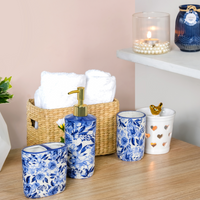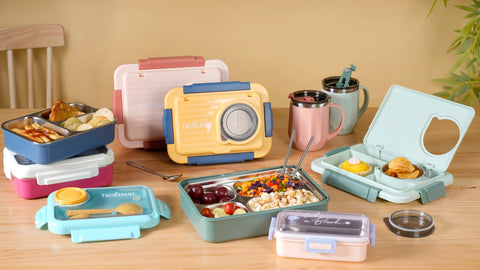Healthy food, shelter, and clothes are the three most crucial things that we need in our everyday lives. However, even if we have the shelter and clothes part figured out, something we forget to pay attention to in our day-to-day busy lives is the food we consume. But even then, another important thing that we forget is the materials with which we are consuming our food. That is because most of the time we are outside of our homes, working full-time jobs that take up a lot of our energy, and we don't always have time to see what and how we are consuming food.
However, it is important to remember that even our smallest habits have a big effect on our lives. Hence, it is important that when you pack your lunch for your office, you do it in lunch boxes that are of the best material and that won't affect your health in any way. The most common materials that lunch boxes are typically made of are glass, plastic, stainless steel, and more. In this blog, we will explore which criteria to look for when shopping for a lunch box and how you can choose the best materials for a lunch box.
Which criteria to check when it comes to choosing a lunch box material?
As mentioned above, there are several materials that lunch boxes are made of nowadays. There are plastic lunchboxes, glass lunch boxes, silicone lunch boxes, and stainless steel lunch boxes that are available both online and offline. Before choosing a material for a lunch box, you should first consider some useful criteria.
- Hygiene and cleanliness: You should first consider if the material of your lunchbox is easy to clean and to keep free from germs and bacteria.
- Durability and lifespan: Consider whether the material of your lunchbox is good for use every day without showing signs of wear and tear, and also how long it will last.
- Versatility: Check whether the lunch box that you are going to buy can be put in the freezer, oven, or microwave.
- Affordability: It is a no-brainer that you should choose a lunchbox that is completely within your budget. However, you must not compromise on quality, especially when it comes to your food and health.
- Non-toxic and sustainable: You should consider the factor of eco-friendliness when choosing the best lunchbox material, as well as the safety of said material.
- Weight: If you have to carry your lunch box to work and carry it back home, you should be thinking about a lightweight material for a lunchbox that also preserves the nutritional integrity of your food.
Materials that are commonly used in lunch boxes
Most lunchboxes are made from plastic, silicone glass, or stainless steel. Here’s a breakdown of each type of lunchbox and its pros and cons.
Plastic
Most lunchboxes that you would find in the market, both online and offline, would be made of plastic. It is true that plastic is quite affordable, versatile, and lightweight too. However, plastic is not eco-friendly at all, and the downside is that it is quite polluting.
Moreover, plastic lunchboxes are especially bad for your health and food as they shed microplastics, which leach into your food.
If you are on a budget and are getting a plastic lunch box, you should choose the best quality lunchbox you can find that is both BPA and phthalate-free. However, there are many other affordable options other than plastic that we will speak about further.
Bamboo
Bamboo is an unconventional material choice for lunchboxes. However, they are incredibly environmentally friendly. Since bamboo is a fast-growing plant, no pesticides or herbicides are used on it for growth. Though you may use bamboo lunchboxes, there are things that you must be aware of. Bamboo cups and lunchboxes contain chemicals like glue, formaldehyde, and melamine for binding, which make them quite toxic and not safe for food intake.
Glass
For luxury and style, glass lunch boxes can be the best choice. They are eco-friendly in the sense that they can be easily recycled, and with proper care, they last a long time as well. They don't leach chemicals or harmful materials into your food. They are also easy to clean and don't hold odours.
However, glass lunch boxes are fragile, so if they are not treated with care, you will lose out on your investment. Moreover, these lunch boxes can also be heavy sometimes. If you travel to work nearby, glass lunch boxes can be a good option for you. It is definitely not recommended for kids, though!
Silicone
Silicone is a great sealing agent and is used to create leakproof seals and lids. Silicone is also a material used to create lunchboxes themselves. Its properties are similar to those of plastic, as both are flexible and lightweight. Moreover, it is similar to plastic in the sense that it contains petrochemicals and can only be recycled at specific facilities.
However, silicone is a safer material for lunchboxes than plastic and doesn't shed microplastics. It is also durable and long-lasting. If you have a higher budget, invest in a silicone lunch box instead of a plastic one.
Stainless steel
Since the 1900s, lunchboxes have been made of metal, and people nowadays have been looking for alternatives to plastic lunch boxes. Basically, stainless steel lunchboxes are fashionable again. Ah, the nostalgia!
It’s quite easy to see why stainless steel lunchboxes have been gaining popularity. Firstly, they are perfect in terms of non-toxicity and eco-friendliness. Secondly, they are quite durable and long-lasting too. Easy to clean, stainless steel lunchboxes don’t harbour unwanted bacteria, stains, or smells. Stainless steel lunchboxes are great for people of all ages- for kids and also for people who are on the go.
Which would be the best lunchbox material for you?
Now that you know the pros and cons of each type of material used for lunchboxes, you may have already made your choice. However, if you are still unsure of which type of material to go for when it comes to a lunchbox, the first things to consider are the quality and your budget. Besides, you must consider the amount of food you will be taking and choose a lunchbox with various compartments.
In terms of hygiene, cleanliness, durability, and non-toxicity, stainless steel and glass lunchboxes would be the best choices if you have an ample budget. For versatility, you can get some stainless steel lunchboxes that are outwardly coated to be microwave- and oven-safe.
Silicone lunchboxes are always better than plastic and would also fit most of the criteria that you would look for in a lunch box. However, if you have the right budget, the best pick for you would be stainless steel lunchboxes or glass lunch boxes, which have silicone sealings for durability and cleanliness.
Also visit: https://nestasia.in/collections/kitchen


























